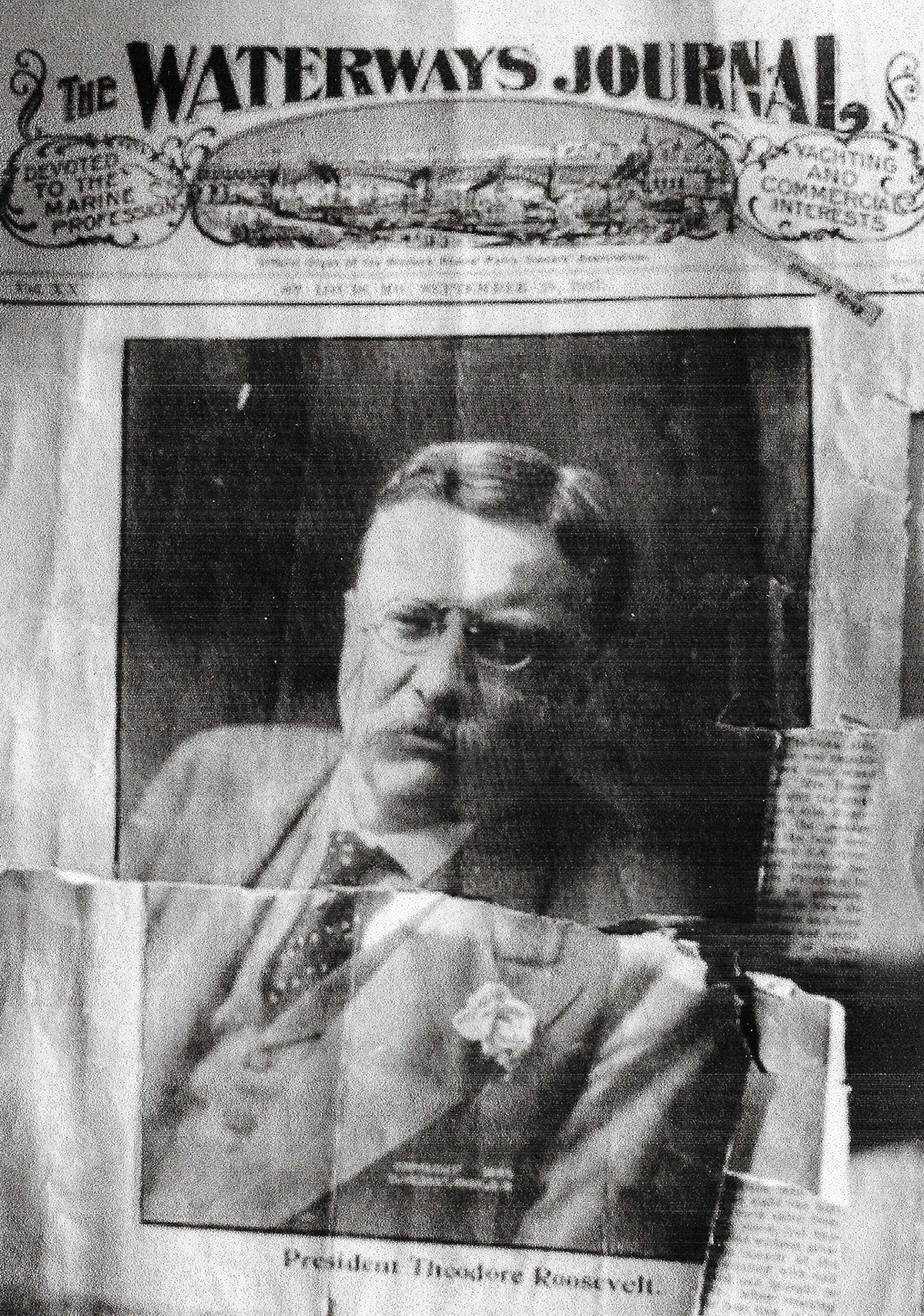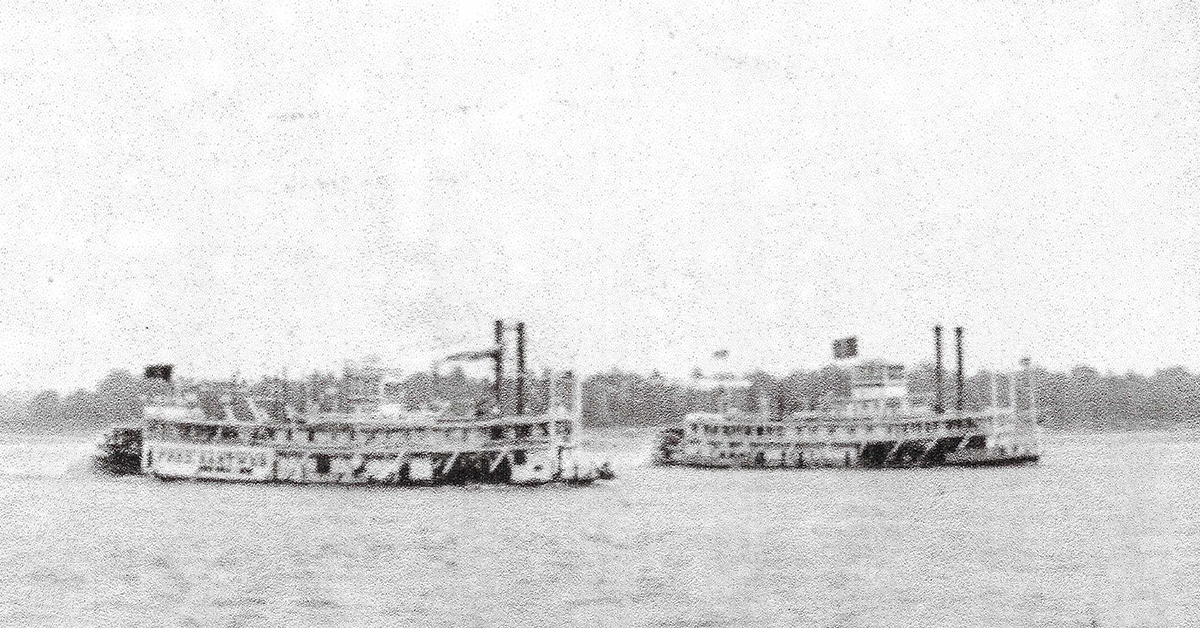There is much in the news these days regarding presidential or executive orders. Five score and 18 years ago (118 years), an incident occurred during a steamboat parade down the Mississippi River that resulted in the master of one of the vessels facing a hearing before the local steamboat inspectors. His license was then suspended from what was essentially an order by the sitting president of the United States.
The oldest copy of The Waterways Journal in this writer’s collection is the issue of September 28, 1907 (graciously gifted by Capt. Jeff Yates a few years ago). The issue resides in a plastic sleeve due to the brittle, time-worn condition of the front cover, which features a portrait of President Theodore Roosevelt. Inside was the news that Roosevelt would be the featured speaker at the October 4, 1907, convention of the Lakes-to-the-Gulf Deep Waterways Association (DWA) at Memphis, Tenn. Also within this issue is a large story about the first steamboat on Western Rivers, the New Orleans of 1811, built by Nicholas Roosevelt, a great-grand uncle of President Roosevelt.
Once Roosevelt accepted the invitation to speak at the DWA convention, association leaders wanted to showcase the river industry to impress the president. Roosevelt himself wanted to know more about it, so a grand parade was arranged. Roosevelt would board the Mississippi River Commission inspection steamer Mississippi at Keokuk, Iowa. The Mississippi would then journey south to Memphis, accompanied by other steamboats. Stops were scheduled along the way for citizens to see the president, who made speeches in St. Louis and Cairo, Ill. Other boats in the parade above Cairo included the government steamers Col. A. MacKenzie and Lily, along with several passenger steamers. At Cairo, the towboat Fred Hartweg of the Monongahela River Consolidated Coal & Coke Company (referred to by rivermen as “the Combine”) joined the parade. That’s when things got interesting.
The DWA requested that the Combine send the giant towboat Sprague, the largest towboat ever built, to take part in the parade, but it was undergoing repairs at Paducah, Ky., and was, thus, unavailable. The Hartweg, a mid-sized towboat built in 1896 in Brownsville, Pa., was sent instead. The vessel had a wood hull that measured 160 feet by 29 feet. The Hartweg had high-pressure engines that were 18’s, seven-foot stroke. It was known as a fast vessel when running lite boat, and it probably had a model bow, as many towboats did in that era.
Capt. Clarence Nichols of Cairo was in charge of the Fred Hartweg, and several prominent guests, including Capt. W.B. Rodgers, Capt. James A. Henderson, W.L. Hirsch, Thomas M. Rees, Capt. John A. Wood, John Eichleay Jr., Capt. John Moren and others from the Pittsburgh River industry, were aboard for the event. A party atmosphere was present aboard, and the late Capt. Fred Way, writing about this in the S&D Reflector, wondered “how much liquid cheer was involved.”
The Mississippi was in the lead of the parade, with the Col. A. MacKenzie next, followed by the Hartweg. Several times, the fast Hartweg pulled up next to the Mississippi, apparently trying to jockey for the lead with the celebrants aboard yelling “Teddy!” to gain the attention of the nation’s chief executive. They were, no doubt, unaware or not concerned that Roosevelt did not care for the nickname.
Each time this occurred, the pilots aboard the Mississippi and/or the MacKenzie warned the Hartweg by megaphone to get back in line. However, just above Memphis, the Hartweg once again poured on the steam and raced past the presidential vessel to attain the lead and arrive ahead of the pack. It was later reported that the president “immediately” sent a telegram to Gen. George Uhler, supervising inspector of steamboats, Washington, D.C., that read: “I DIRECT THAT THE LICENSE OF THE MASTER, OR WHOEVER IS RESPONSIBLE FOR THE FRED HARTWEG DURING THE PRESENT VOYAGE, BE SUSPENDED AT ONCE FOR 90 DAYS. I WISH THIS DONE BY TELEGRAPH WHEREVER THE BOAT MAY BE, IF SUCH PROCEDURE IS POSSIBLE. CO. SEARS CAN GIVE YOU THE DETAILS OF HIS CONDUCT, WHICH HAS BEEN OF A SERIOUS NATURE AND MIGHT HAVE AT ANY TIME CAUSED AN ACCIDENT TO THIS BOAT AS WELL AS OTHER BOATS. – THEODORE ROOSEVELT

While this telegram was indeed sent, it was not immediate and not to Uhler. The newspaper reports were somewhat embellished. It seems that the pilots of the Mississippi met with Roosevelt over the matter before he stepped off at Memphis. Before he boarded a train to depart that evening, he met with the local Steamboat Inspectors. The telegram was actually sent to the Steamboat Inspectors at Evansville, Ind. The upshot was that a hearing took place in Memphis on October 5, and Capt. Nichols, charged with “reckless navigation,” had his license suspended, not for the 90 days that Roosevelt requested but for 180 days.
Many, including historian Jack Custer, have opined that Nichols did not receive a fair hearing since no specific vessel order had been provided to the boats. At any rate, this remains the sole instance of a river pilot having action taken against his or her license by presidential order. Capt. Nichols served as a clerk in the Combine offices until his license was reinstated. He then rejoined the Hartweg.
The Combine sold the boat to the Barrett Line in 1912, and it was renamed Dorothy Barrett. The vessel was lost in ice at Richardson Landing, Tenn., in 1918.
Featured image caption: The steamer Fred Hartweg passing the U.S. steamer Mississippi on October 4, 1907. (Photo courtesy S&D Reflector)



